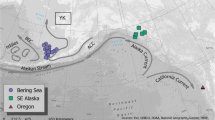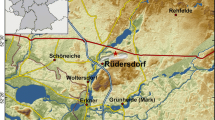Abstract
A high-resolution sampling technique for stable-isotope measurements in otoliths is now available, but little is known about the precision and accuracy of the results when using this technique. Otolith samples of pen-reared cod (Gadus morhua L.) with well-defined temperature history were obtained using this high-resolution sampling technique. Samples from different-aged cod otoliths were collected in two yearly increments corresponding to the calendar years 1994 and 1995, and the stable-oxygen (δ 18O) and -carbon (δ 13C) isotope compositions of the samples were measured. Otolith δ 18O values had a clear seasonal pattern in response to the seasonal water temperature. Otolith material deposited in the same calendar years of different-aged fish showed similar δ 18O values. High precision of the temperature estimate using otolith δ 18O values was obtained when comparing results from different otoliths. The accuracy of the temperature estimates, relative to measured mean monthly water temperature, was also high, but reduced sampling resolution in the otoliths significantly reduced the accuracy due to attenuation of the δ 18O signals. We found that the otolith δ 13C values had a cyclic pattern, roughly in phase with the δ 18O values. This was most likely caused by temperature-increased metabolism. Indications of age-specific otolith δ 13C values are also presented.








Similar content being viewed by others
References
Begg GA, Weidman CR (2001) Stable δ 13C and δ 18O isotopes in otoliths of haddock, Melanogrammus aeglefinus, from the northwest ocean. Mar Ecol Prog Ser 216:223–233
Bjørnsson B, Steinarsson A (2002) The food-unlimited growth rate of Atlantic cod (Gadus morhua). Can J Fish Aquat Sci 59:494–502
Brett JR, Groves TDD (1979) Physiological energetics. In: Hoar WS, Randall DJ, Brett JR (eds) Fish physiology. Academic, London, pp 279–352
Campana SE (1996) Year-class strength and growth rate in young Atlantic cod Gadus morhua. Mar Ecol Prog Ser 135:21–26
Campana SE (1999) Chemistry and composition of fish otoliths: pathways, mechanisms and applications. Mar Ecol Prog Ser 188:263–297
Campana SE (2001) Accuracy, precision and quality control in age determination, including a review of the use and abuse of age validation methods. J Fish Biol 59:197–242
Campana SE, Neilson JD (1985) Microstucture of fish otoliths. Can J Fish Aquat Sci 42:1014–1032
Frew RD, Dennis PF, Heywood KJ, Meredith MP, Boswell SM (2000) The oxygen isotope composition of water masses in the northern North Atlantic. Deep-Sea Res 47:2265–2286
Fry B (1988) Food web structure on Georges Bank from stable C, N and S isotopic composition. Limnol Oceanogr 33:1182–1189
Gao Y, Schwarcz HP, Brand U, Moksness E (2001) Seasonal stable isotope records of otoliths from ocean-pen reared and wild cod, Gadus morhua L. Environ Biol Fishes 61:445–453
Goodwin DH, Schöne BR, Dettman DL (2003) Resolution and fidelity of oxygen isotopes as paleotemperature proxies in bivalve mollusk shells: models and observations. Palaios 18:110–125
Høie H, Folkvord A, Otterlei E (2003) Effect of somatic and otolith growth rate on stable isotopic composition of early juvenile cod (Gadus morhua L.) otoliths. J Exp Mar Biol Ecol 289:41–58
Hüssy K (2002) Otoliths of juvenile cod (Gadus morhua L.): composition, microstructure and growth. PhD thesis, University of Copenhagen, Copenhagen, Denmark
Jobling M (1988) A review of the physiological and nutritional energetics of cod, Gadus morhua L., with particular reference to growth under farmed conditions. Aquaculture 70:1–19
Kalish JM (1991a) Oxygen and carbon stable isotopes in the otoliths of wild and laboratory reared Australian salmon (Arripis trutta). Mar Biol 110:37–47
Kalish JM (1991b) Determinants of otolith chemistry: seasonal variation in the composition of blood plasma, endolymph and otoliths of bearded rock cod Pseudophycis barbatus. Mar Ecol Prog Ser 74:137–159
Kim S-T, O’Neil JR (1997) Equilibrium and nonequilibrium oxygen isotope effects in synthetic carbonates. Geochim Cosmochim Acta 61:3461–3475
Leder JJ, Swart PK, Szmant AM, Dogde RE (1996) The origin of variations in the isotopic record of scleractinian corals. I. Oxygen. Geochim Cosmochim Acta 60:2857–2870
McConnaughey T, McRoy CP (1979) Food-web structure and the fractionation of carbon isotopes in the Bering Sea. Mar Biol 53:257–262
Otterlei E, Folkvord A, Nyhammer G (2002) Temperature dependent otolith growth of larval and early juvenile Atlantic cod (Gadus morhua). ICES J Mar Sci 59:401–410
Pálsson ÓK (1994) A review of the trophic interactions of cod stocks in the North Atlantic. ICES Mar Sci Symp 198:553–575
Panfili J, Pontual H (de) Troadec H, Wright PJ (eds) (2002) Manual of fish sclerochronology. Ifremer and IRD, Brest, France
Pannella G (1971) Fish otoliths; daily growth layers and periodic patterns. Science 173:1124–1127
Patterson WP (1998) North American continental seasonality during the last millennium: high-resolution analysis of sagittal otoliths. Palaeogeogr Palaeoclimato Palaeoecol 138:271–303
Patterson WP, Smith GR, Lohmann KC (1993) Continental paleothermometry and seasonality using the isotopic composition of aragonitic otoliths of freshwater fishes. Geophys Monogr 78:191–202
Peterson BJ, Fry B (1987) Stable isotopes in ecosystem studies. Annu Rev Ecol Syst 18:293–320
Radtke RL, Showers W, Moksness E, Lenz P (1996) Environmental information stored in otoliths: insights from stable isotopes. Mar Biol 127:161–170
Radtke RL, Showers W, Moksness E, Lenz P (1998) Corrigendum: environmental information stored in otoliths: insights from stable isotopes. Mar Biol 132:347–348
Reibisch J (1899) Ueber die Einzahl bei Pleuronectes platessa und die Altersbestimmung dieser Form aus den Otolithen. Helgol Wiss Meeresunters 4:233–248
Romanek CS, Grossman EL, Morse JW (1992) Carbon isotopic fractionation in synthetic aragonite and calcite: effects of temperature and precipitation rate. Geochim Cosmochim Acta 56:419–430
Schwarcz HP, Gao Y, Campana S, Browne D, Knyf M, Brand U (1998) Stable carbon isotope variations in otoliths of Atlantic cod (Gadus morhua). Can J Fish Aquat Sci 55:1798–1806
Sherwood GD, Rose GA (2003) Influence of swimming form on otolith δ 13C in marine fish. Mar Ecol Prog Ser 258:283–289
Smestad OM, Holm JC (1996) Validation of back-calculated formulae for cod otoliths. J Fish Biol 49:973–985
Syvitski JPD, Burrell DC, Skei JM (1987) Fjords, processes and products. Springer, New York Heidelberg Berlin
Thorrold SR, Campana SE, Jones CM, Swart PK (1997) Factors determining δ 13C and δ 18O fractionation in aragonitic otoliths of marine fish. Geochim Cosmochim Acta 61:2909–2919
Volk EC, Schroder SL, Grimm JL (1999) Otolith thermal marking. Fish Res (Amst) 43:205–219
Weidman CR, Millner R (2000) High-resolution stable isotope records from North Atlantic cod. Fish Res (Amst) 46:327–342
Wurster CM, Patterson WP, Cheatham MM (1999) Advances in microdrilling techniques: a new apparatus for acquiring high-resolution oxygen and carbon stable isotope values and major/minor elemental ratios from accretionary carbonate. Comput Geosci 25:1159–1166
Acknowledgements
This work has been financed by the Norwegian Research Council grant no. 130192/140 and the EU project Q5RS-2002–01610. The experiments comply with the current laws of Norway.
Author information
Authors and Affiliations
Corresponding author
Additional information
Communicated by M. Kühl, Helsingør
Rights and permissions
About this article
Cite this article
Høie, H., Andersson, C., Folkvord, A. et al. Precision and accuracy of stable isotope signals in otoliths of pen-reared cod (Gadus morhua) when sampled with a high-resolution micromill. Marine Biology 144, 1039–1049 (2004). https://doi.org/10.1007/s00227-003-1275-5
Received:
Accepted:
Published:
Issue Date:
DOI: https://doi.org/10.1007/s00227-003-1275-5




